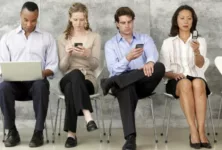With nearly two billion smartphone users worldwide, the number of publications examining the effects of smartphone use on our health and psyche has grown rapidly. Researchers argue that smartphone data can contribute a lot as a research tool in psychology, yet few use objective data, the practiced use of self-reported data has limited validity and should be accompanied by real-behavior measurements.
Researchers at the University of Lincoln analyzed the behavior of 29 participants, statistically calculated as an adequate number for finding the correlation between actual and self-reported usage, using an app to collect the data. The app recorded a timestamp when the phone became active and another to record when the phone was not used anymore. After 14 days, the participants were asked to estimate how much they used their phone on average each day (including calls and listening to music). This measure was used in subsequent analyses of subjective estimates. They were then asked to estimate how many times they use their phone each day, and finally were asked to complete the MPPUS (Mobile Phone Problem Use Scale: a questionnaire used in research to measure mobile use).
According to the gathered data (you can see the graphs on the next page)
Participants used their phones a mean of 84.68 times each day compared to their estimated 37.2 and spent 5.05 hours each day using their smartphone compared to their estimated 4.12 (including calls and listening to music). Length of use was highly skewed, with 55% of all uses less than 30 seconds in duration. The usage time under 15 seconds was also analysed showing peaks in “checking” duration at 1-3s, 5-6s and 10-11s. The average time to read a message was measured to be 8.42s (estimated 1.53s), which could relate the 10-11s peak to reading messages and the shorter peaks to checking time or notifications. The researchers also compared phone use at different times of day, showing that the phones were used more often in the afternoon compared to mornings followed by nights.
The data shows that we have a pretty good idea of how much we use our phone but not a good perception of how often. Smartphone usage has been related to sleep, driving safety, relationships and even personality, we use our phones for a variety of normal chores like checking the time, setting an alarm, checking notifications and they have partially replaced desktop computers for checking emails and using the internet. Researchers believe heavy usage is not necessarily a problem but it is reasonable to assume those who spend a long time on their phone have problem mobile phone use. This is the first time that a method has been provided to automatically sample and visualise the frequency of smartphone use, the developers used an open source software to develop an app and analyze the acquired data. they hope it will help “overcome some barriers to accessing smartphone data for research in psychology and that it will form a foundation to build upon in the coming years.”
You can see the usage graphics on the following page

Percentage of uses categorised by duration.
This illustrates the highly skewed nature of smartphone usage.

Number of checks in 0.5 second bins across all participants over a 15 second period.
Three spikes of checking duration are visible.

Participants’ mean number of phone uses (a), mean total duration (b), and mean duration length (c) at different times of day.
The original article can be found here.








